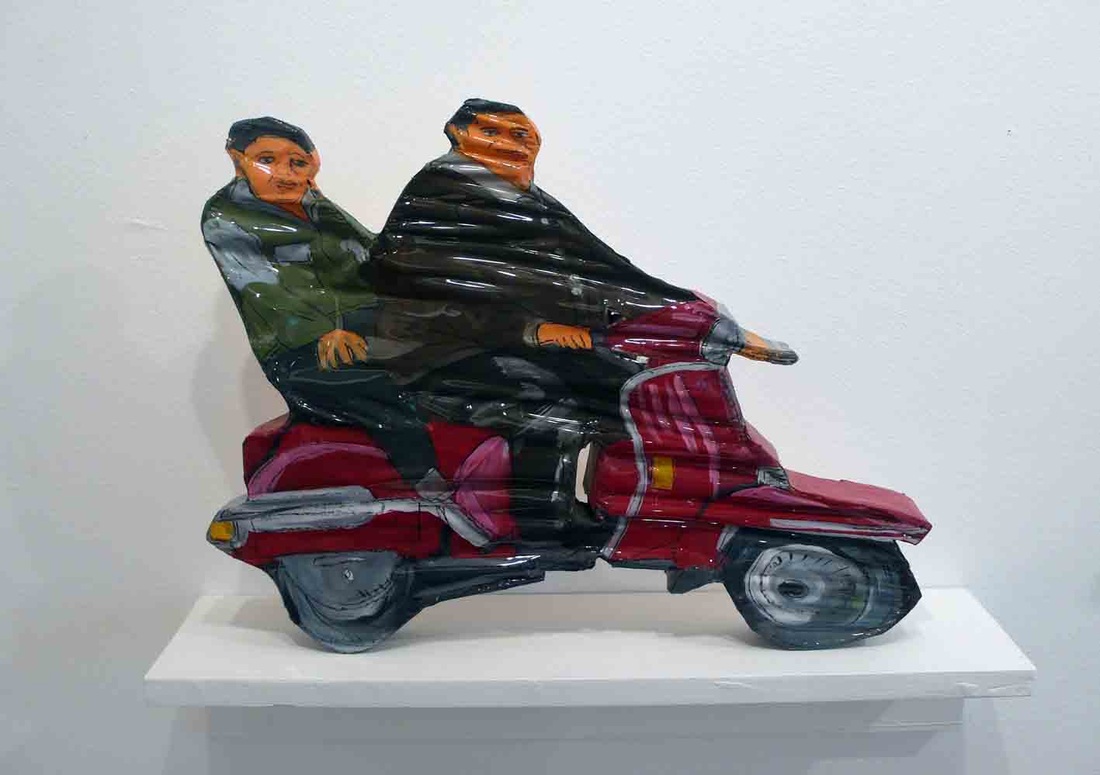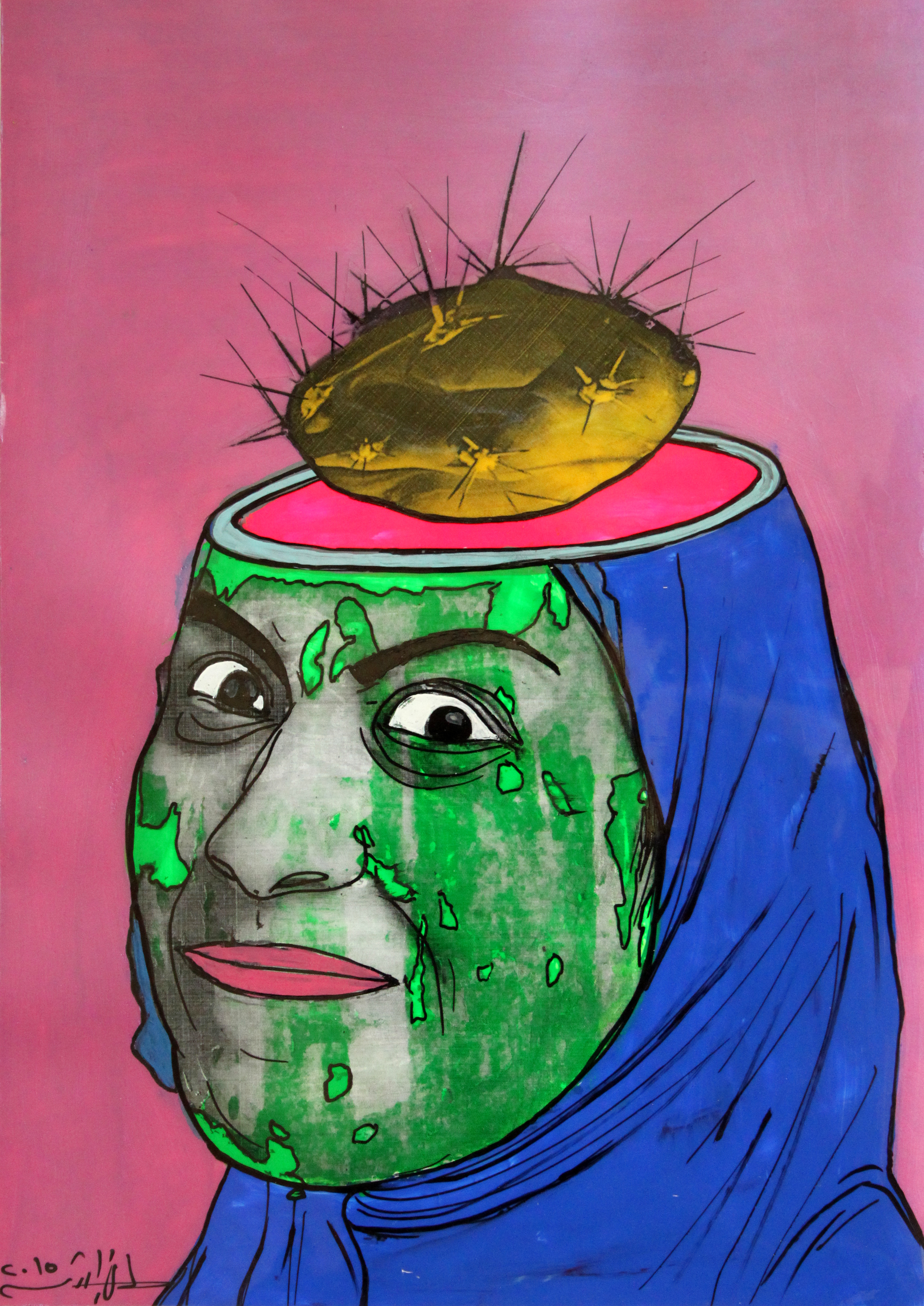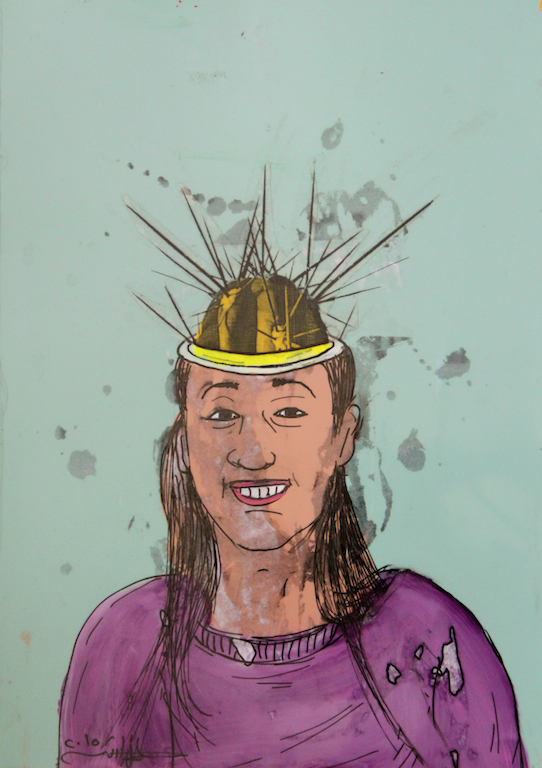In his exhibition Bulldozer at Cairo’s Mashrabia Gallery this May of 2015 and in his previous show Toys in May 2014 Egyptian artist Hany Rashed (building on a long line of earlier work) puts people front and center. The gallery is the same: the rooms and walls are the same; the streets outside are the same. But Egypt mid-2015 is not the Egypt of mid-2014. Lurking behind an aura of calm indifference an anxious mood is palpable as people go about their daily lives. Moving about in an unsettling environment one can see tension settling deeply in people’s psyches.
Into this dense environment comes Hany Rashed with his bulldozer, cutting and slicing, and throwing up all manner of debris whether psychological or physical. It is a sight to behold—to recoil from. Calling his new exhibition Bulldozer, the artist splices in yellow bulldozers among people. Rashed explains that he uses the bulldozer as a symbol of demolition and of rebuilding. He started off wanting to show the ravaging work of the bulldozer and then moved to a second stage seeking to portray it as an instrument of reconstruction. In the process, Rashed, confides, he became the bulldozer. He then no longer needed to depict the device itself.
Hany Rashed, “artist of people,” and “the people’s artist,” was born in 1975 in al-Ghuriyya, a neighborhood in the populous old Fatimid area rich in street life and Islamic architectural treasures. He worked as an electrician in the state television building in Maspero in the early 1990s. During this time he began to scribble caricatures that came to the attention of the artist Mohamed Abla who in 1994 began to mentor the young Rashed offering him space in his studio near the Hussain Mosque for a period that stretched into a decade before the budding artist ventured out on his own. Over the years he showed his work in numerous solo and group exhibitions in Egypt and abroad.
In his two most recent exhibitions in Egypt, Toys and Bulldozers, the artist reveals the breadth of his technical agility and the depth of his keen sensors. He inventively fuses technique and content while his creativity is deeply rooted in context. Appropriating photographs—an intrinsic part of his artistic arsenal—he paints on sheets of plastic: sometimes he stretches the plastic to create a rippling affect that animates a piece and at other times he pulls it tight to produce a still smoothness. He might paint on the front of the plastic sheet or do “reverse-painting,” working on one side of the plastic sheet and then swiveling it so it becomes a kind of see-through piece, the way bazaar painters of old worked on glass.
 [An example of Hany Rashed`s Toys (2014). Image copyright the artist. Courtesy of Mashrabia Gallery.]
[An example of Hany Rashed`s Toys (2014). Image copyright the artist. Courtesy of Mashrabia Gallery.]
The photographs Rashed draws up for the two exhibitions are of a different order. In Toys he worked from photographs he took himself. In Bulldozer he assembled a cache from pictures Egyptians posted on the Internet. In the case of the former his eye created the “raw” archive from which he worked. With the latter the artist’s starting point were the pictures others took, their views of themselves. The methodology and the moment that gave rise to Toys and Bulldozer are different. In the two exhibitions Rashed moves from somber realism to shrill expressionism.
The photographs of people Rashed took between the second half of 2013 and the early months of 2014 as he wandered widely among the streets of Cairo became the basic building blocks of Toys. He snapped the listlessness and resignation of the people he found in this period of uncertainty, in disturbing contrast to the movement, energy, and vitality Egyptians had displayed in the days of open revolutionary activism and in which he took part.
In Toys, Rashed presents figurines of women and men he fashioned from plastic and wood. Some he packaged in transparent plastic bags with paper labels carrying their names. They are grouped together in one area of the Mashrabia Gallery dangling from plastic strings as in toy shops, and swing and sway as viewers meander amongst them. In another room, the figurines are arrayed on the gallery floor heading in different directions ostensibly going about their daily affairs. We can see “real” people in these figures “pacing” the street, exhausting themselves in everyday tasks while not actually getting anywhere. Stuck in place, they are immobilized, while projecting the illusion of movement. Their eyes unite them. Not because they look at each other, which they do not, but because they are the same: tired, dulled, sad. The figurines appear in dim hues. They and their clothes have a faded look.
Along with the figurines dangling from the ceiling and planted on the floor, the artist displays on the gallery walls pictures of people engaged in mundane activities. But it is his pictures of cars, buses, taxis, and toc tocs, or the three wheelers found in the ashwiyyat (the poor popular quarters), rendered on stretched wavy plastic that convey a sense of energy and motion missing in the figures.
The world of the Bulldozer is strikingly different. Here the artist splashes wild color saturating his works with clashing pigments. The color stares at us, glares at us in visual screams producing jarring and nightmarish sensations. We cannot just walk by. We have to stop and look. We are commanded to see. The portraits in Bulldozer huddled together in the front room to the right of the gallery entrance, with their staring eyes rivet our attention. They alert us to what lies ahead in the rest of the gallery. If viewers could walk through the Toys with indifference, this is not an option with the Bulldozer works blaring out disturbing dissonance. It is as if the long arm of the yellow bulldozer is grabbing us as well as those inside the frames.
 [untitled (2015), from the Bulldozer series. Image copyright the artist. Courtesy of Mashrabia Gallery]
[untitled (2015), from the Bulldozer series. Image copyright the artist. Courtesy of Mashrabia Gallery]
The primary “raw” material Rashed used in making his Bulldozer pictures, as mentioned, is of a different order from that used in Toys. Instead of walking the streets of Cairo, Rashed roamed the Internet and social media, especially Facebook. Rather than snapping he downloaded. He harvested photographs Egyptians took and posted of themselves and friends: a rich cornucopia of selfies. Such images revealed how people liked to see themselves and how they wished others to see them. In appropriating these photographs to produce his artworks the artist brought his own way of seeing, an eye formed in the turmoil of Egyptian streets and public spaces rather than in the sterile de-contextualized terrain of the Internet. The artist connected what appears in the comfort zone of the Internet with the tumult of terra in/ferma.
In the portraits Rashed created from re-worked selfies women predominate. Sometimes they are part of a couple. When I asked Rashed why there were so many women in the portraits he told me that he found women post selfies more often than men. Could it be that women find a safer public presence in virtual space than in real space where tahharush (sexual molesting) is epidemic? As “Internet selfies” women also have the possibility of enjoying visibility with anonymity.
 [untitled (2015), from the Bulldozer series. Image copyright the artist. Courtesy of Marshrabia Gallery.]
[untitled (2015), from the Bulldozer series. Image copyright the artist. Courtesy of Marshrabia Gallery.]
The artist scrutinized the downloaded pictures with his piercing eye seeing beyond the surface “normal,” finding wild dazed looks in people’s eyes and shock and disorientation in a world where anxieties and uncertainties lace lives. The artist distorts and mutilates. He slices tops off heads, out of which a second head often appears or sometimes a cactus, the prickly pear or tin shawqi with its long needles (and succulent fruit) common in Egypt. The (stubborn) cactus, Rashed explains, is a person’s self- defense system. This hardy plant symbolizes vigor while its sharp needles stave off attack. The “cactus pictures” mesmerize and disturb as they concentrate our attention and force us to think. They can also amuse (Rashed is known for his biting wit) like the picture of a barber trimming a cactus growing out of a man’s head. “The woman,” “the man,” ”the couple,” and “the family” (commonly called society’s building block) are all caught up in the tangle of manipulation and dissonance.
.jpg) [untitled (2015), from the Bulldozer series. Image copyright the artist. Courtesy of Mashrabia Gallery.]
[untitled (2015), from the Bulldozer series. Image copyright the artist. Courtesy of Mashrabia Gallery.]
.jpg) [untitled (2015), from the Bulldozer series. Image copyright the artist. Courtesy of Mashrabia Gallery.]
[untitled (2015), from the Bulldozer series. Image copyright the artist. Courtesy of Mashrabia Gallery.]
In Bulldozer there is a single portrait against a purple background of an androgynous figure: an old woman with pink-red skin and black garment and a sprig of green like a hat jauntily placed on her head. Stoic but not defeated she transmits strength and serene wisdom. Her old eyes look beyond.